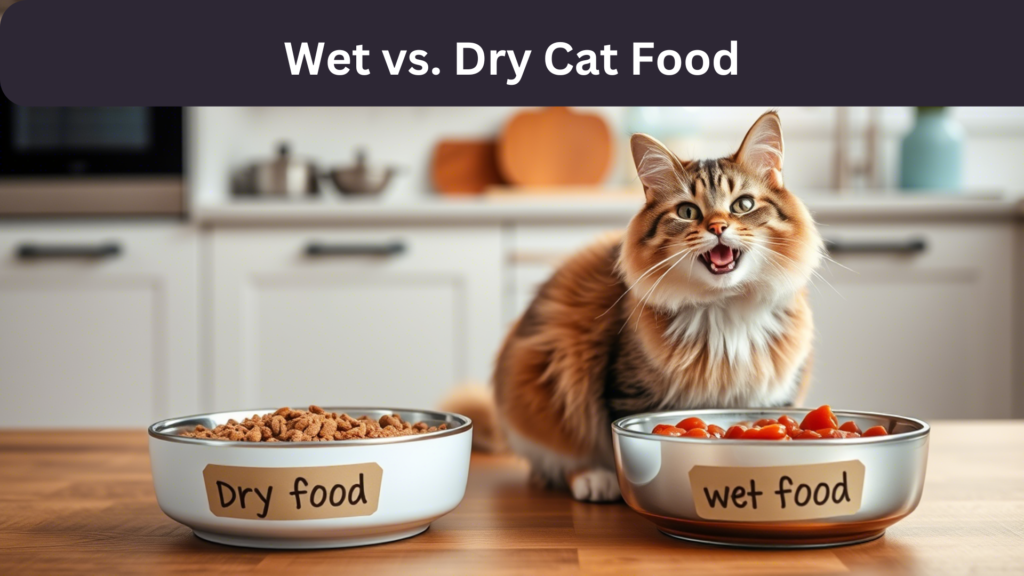Wet vs. Dry Cat Food: Which is Better for Your Pet’s Health
If you’ve ever stood in the pet food aisle, staring at rows of kibble and cans, wondering, “Which is better for my cat?”—you’re not alone. The wet vs. dry cat food debate is one of the most common dilemmas pet parents face. Both options have their champions and critics, but the truth is, the “best” choice depends on your cat’s unique needs.

In this article, we’ll dive into the pros and cons of wet and dry cat food, backed by veterinary science, real-world examples, and expert insights. By the end, you’ll have a clear understanding of which option—or combination—might be the perfect fit for your furry friend. Let’s dig in!
The Basics: What’s the Difference?
Before we compare, let’s define the two:
- Wet Cat Food: Comes in cans or pouches, with a high moisture content (70–80%). It’s often meatier and more aromatic.
- Dry Cat Food: Kibble with a low moisture content (around 10%). It’s convenient, cost-effective, and shelf-stable.
Both can be nutritionally complete, but they serve different purposes and cater to different lifestyles.
Wet Cat Food: The Hydration Hero
Pros:
- High Moisture Content: Cats are notorious for not drinking enough water, which can lead to kidney and urinary issues. Wet food helps keep them hydrated.
- Stat Alert: Cats on wet food diets consume 50% more water than those on dry food, reducing the risk of urinary tract diseases.
- Lower in Carbohydrates: Wet food is closer to a cat’s natural diet, which is high in protein and low in carbs.
- Palatability: The strong smell and texture often appeal to picky eaters or senior cats with diminished senses.
Cons:
- Shorter Shelf Life: Once opened, wet food spoils quickly and must be refrigerated.
- Cost: It’s generally more expensive than dry food.
- Dental Health: Unlike kibble, wet food doesn’t scrape plaque off teeth, potentially leading to dental issues.
Expert Insight: Dr. Lisa Pierson, DVM, founder of CatInfo.org, advocates for wet food, stating, “Cats are desert animals and don’t have a strong thirst drive. Wet food mimics their natural prey, which is 70–75% water.”
Read More :- Top 5 Health Issues in Cats and How to Prevent Them
Dry Cat Food: The Convenience King
Pros:
- Convenience: Kibble can be left out for free-feeding without spoiling, making it ideal for busy pet parents.
- Dental Benefits: The crunchy texture can help reduce plaque buildup.
- Case Study: A 2021 study found cats fed dry food had 20% less tartar than those on wet-only diets.
- Cost-Effective: Dry food is generally cheaper per serving than wet food.
Cons:
- Low Moisture Content: Cats on dry food diets are at higher risk of dehydration, which can lead to kidney and urinary problems.
- Higher in Carbs: Many dry foods contain fillers like corn and wheat, which aren’t ideal for obligate carnivores.
- Overeating Risk: The ease of free-feeding can lead to obesity if portions aren’t controlled.
Expert Insight: Dr. Karen Becker, DVM, warns, “Dry food is like feeding your cat cereal. It’s convenient but not biologically appropriate for their needs.”
Health Considerations: Which is Better?
The answer depends on your cat’s age, health, and lifestyle:
For Hydration & Urinary Health:
- Winner: Wet Food
Cats prone to urinary crystals or kidney disease benefit from the extra moisture.
For Dental Health:
- Winner: Dry Food (with caveats)
While kibble can help with plaque, it’s not a substitute for regular dental care.
For Weight Management:
- It Depends: Wet food is lower in calories, but dry food can be portion-controlled more easily.
For Senior Cats:
- Winner: Wet Food
Older cats often have dental issues or decreased thirst drives, making wet food easier to eat and digest.
The Best of Both Worlds: Combining Wet and Dry Food
Many experts recommend a mixed feeding approach to balance the benefits of both:
- Example Schedule: Serve wet food in the morning and evening, with a measured portion of dry food available during the day.
- Benefits: Combines hydration, convenience, and dental benefits.
Pro Tip: Always consult your vet before making dietary changes, especially if your cat has health issues.
Read More: Best Cat Food for Sensitive Stomach: A Vet-Approved Guide to Happy Tummies
Red Flags to Watch For
- Low-Quality Ingredients: Avoid foods with vague terms like “meat by-products” or excessive fillers.
- Sudden Changes: Transition slowly to avoid digestive upset.
- Allergies: Monitor for itching, vomiting, or diarrhea, which could signal food sensitivities.
Conclusion
So, is wet or dry cat food better? The truth is, there’s no one-size-fits-all answer. Wet food excels in hydration and mimicking a natural diet, while dry food offers convenience and dental benefits. For many cats, a combination of both provides the perfect balance.
Ultimately, the best choice depends on your cat’s age, health, and preferences. Consult your vet, experiment with high-quality options, and observe how your cat responds. After all, a happy, healthy cat is the ultimate goal.
FAQ
Q: Can I feed my cat only wet food?
A: Absolutely! Many cats thrive on wet-only diets, especially if they need extra hydration. Just ensure it’s nutritionally complete.
Q: Is dry food bad for cats?
A: Not inherently, but it’s less ideal for hydration. Choose high-quality, low-carb options and ensure your cat drinks plenty of water.
Q: How much wet food should I feed my cat?
A: Follow the feeding guidelines on the label, adjusting for your cat’s weight, age, and activity level.
Q: Can I mix wet and dry food in the same bowl?
A: Yes, but some cats prefer them separate. Experiment to see what your cat likes best!
